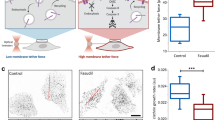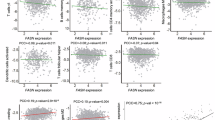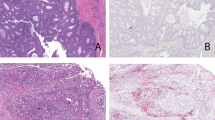Abstract
Expression of membrane-bound Fas ligand (mFasL) on colon cancer cells serves as a potential mechanism to inhibit host immune function by inducing apoptosis of host lymphocytes. Membrane-bound FasL can be cleaved and released as a soluble mediator (sFasL), which may spread the apoptosis induction effect. Our study examined whether colon adenocarcinoma cells release sFasL, and induce apoptosis of host lymphocytes without direct cell–cell contact. In 12 consecutive patients with colon adenocarcinoma mFasL was identified in the tumours, sFasL was measured in the sera and apoptosis identified in tumour-infiltrating and peripheral blood lymphocytes. To analyse the function of sFasL, colon cancer cells were primarily cultured; sFasL was isolated from supernatants, measured, incubated with Fas-bearing Jurkat cells, and the resulting apoptosis was analysed. Serum levels of sFasL were significantly elevated in all colon cancer patients with mFasL expression in tumour tissues (n = 8). In these patients, the number of apoptotic lymphocytes was significantly increased within tumour and peripheral blood. Furthermore, sFasL was present in the corresponding supernatants and induced apoptosis of Jurkat cells in a dose-dependent manner. These findings suggest that mFasL-positive colon cancer cells release sFasL, and thus may induce apoptosis of host lymphocytes as a potential mechanism for immune evasion. © 2001 Cancer Research Campaign http://www.bjcancer.com
Similar content being viewed by others
Article PDF
Change history
16 November 2011
This paper was modified 12 months after initial publication to switch to Creative Commons licence terms, as noted at publication
References
Alderson MR, Tough TW, Davia-Smith T, Braddy S, Falk B, Schooley KA, Goodwin RG, Smith CA, Ramsdell F and Lynch DH (1995) Fas ligand mediates activation-induced cell death in human T lymphocytes. J Exp Med 181: 71–77
Bellgrau D, Gold D, Selawry H, Moore J, Franzusoff A and Duke RC (1995) A role for CD95 ligand in preventing graft rejection. Nature 377: 630–632
Bennett MW, O'Connell J, O'Sullivan GC, Brady C, Roche D, Collins JK and Shanahan F (1998) The Fas counterattack in vivo: apoptotic depletion of tumor-infiltrating lymphocytes associated with Fas ligand expression by human esophageal carcinoma. J Immunol 160: 5669–5675
Bennett MW, O'Connell J, O'Sullivan GC, Roche D, Brady C, Kelly J, Collins JK and Shanahan F (1999) Expression of fas ligand by human gastric adenocarcinomas: a potential mechanism of immune escape in stomach cancer. Gut 44: 156–162
Das H, Imoto S, Murayama T, Kajimoto T, Isobe T, Nakagawa T, Nishimura R and Koizumi T (1999) Levels of soluble FasL and FasL gene expression during the development of graft-versus-host disease in DLT-treated patients. Br J Haematol 104: 795–800
Ghio M, Contini P, Mazzei C, Brenci S, Barberis G, Filaci G, Indiveri F and Puppo F (1999) Soluble HLA class I, HLA class II, and Fas ligand in blood components: a possible key to explain the immunomodulatory effects of allogeneic blood transfusions. Blood 93: 1770–1777
Griffith TS, Brunner T, Fletcher SM, Green DR and Ferguson TA (1995) Fas ligand-induced apoptosis as a mechanism of immune privilege. Science 270: 1189–1192
Halapi E (1998) Oligoclonal T cells in human cancer. Med Oncol 15: 203–211
Hunt JS, Vassmer D, Ferguson TA and Miller L (1997) Fas ligand is positioned in mouse uterus and placenta to prevent trafficking of activated leukocytes between the mother and the concepts. J Immunol 158: 4122–4128
Kato K, Ohshima K, Ishihara S, Anzai K, Suzumiya J and Kikuchi M (1998) Elevated serum soluble Fas ligand in natural killer cell proliferative disorders. Br J Haematol 103: 1164–1166
Korbutt GS, Elliott JF and Rajotte RV (1997) Cotransplantation of allogeneic islets with allogeneic testicular cell aggregates allows long-term graft survival without systemic immunosuppression. Diabetes 46: 317–322
Krammer P, Dhein J, Walczak H, Behrmann I, Mariani S, Matiba B, Fath M, Daniel PT, Knipping E and Westendorp MO (1994) The role of APO-1 mediated apoptosis in the immune system. Immunol. Rev 142: 175–191
Krammer PH, Galle PR, Möller P and Debatin KM (1998) CD95 (APO-1/Fas)-mediated apoptosis in normal and malignant liver, colon, and hematopoietic cells. Adv Cancer Res 75: 251–271
Liu QY, Rubin MA, Omene C, Lederman S and Stein CA (1998) Fas ligand is constitutively secreted by prostate cancer cells in vitro. Clin Cancer Res 4: 1803–1811
Luo JS, Kammerer R, Schultze H and von Kleist S (1997) Modulations of the effector function and cytokine production of human lymphocytes by secreted factors derived from colorectal-carcinoma cells. Int J Cancer 72: 142–148
Luo JS, Kammerer R and von Kleist S (2000) Comparison of the effects of immunosuppressive factors from newly established colon carcinoma cell cultures on human lymphocyte proliferation and cytokine secretion. Tumour Biol 21: 11–20
Matsumoto J, Kawai S, Terao K, Kirinoki M, Yasutomi Y, Aikawa M and Matsuda H (2000) Malaria infection induces rapid elevation of the soluble Fas ligand level in serum and subsequent T lymphocytopenia: possible factors responsible for the differences in susceptibility of two species of Macaca monkeys to Plasmodium coatneyi infection. Infect Immunol 68: 1183–1188
Matute-Bello G, Liles WC, Steinberg KP, Kiener PA, Mongovin S, Chi EZ, Jones M and Martin TK (1999) Soluble fas ligand induces epithelial cell apoptosis in humans with acute lung injury (ARDS). J Immunol 163: 2217–2225
Mukai M, Bohgaki T, Notoya A, Kohno M, Tateno M and Kobayashi S (2000) Liver dysfunction due to apoptosis in a patient with systemic lupus erythematosus. Lupus 9: 74–77
Murayama T, Koizumi T, Das H, Kobazashi Y, Kajimoto K, Sugimoto T, Imoto S, Nishimura R and Nakagawa T (1999) Soluble fas ligand in natural killer cell lymphoma. Am J Haematol 62: 253–255
Nagata S and Goldstein P (1995) The fas death factor. Science 267: 1449–1456
O'Connell J, O'Sullivan GC, Roche D, Brady C, Kelly J, Collins JK and Shanahan F (1996) The fas counterattack: fas-mediated T cell killing by colon cancer cells expressing fas ligand. J Exp Med 184: 1075–1082
O'Connell J, Bennett MW, O'Sullivan GC, Roche D, Kelly J, Collins JK and Shanahan F (1998) Fas ligand expression in primary colon adenocarcinomas: evidence that the fas counterattack is a prevalent mechanism of immune evasion in human colon cancer. J Pathol 186: 240–246
Oyaizu N, Kayagaki N, Yagita H, Pahwa S and Ikawa Y (1997) Requirement of cell–cell contact in the induction of Jurkat T cell apoptosis: the membrane-anchored but not soluble form of FasL can trigger anti-CD3-induced apoptosis in Jurkat T cells. Biochem Biophys Res Commun 238: 670–675
Saito M, Nakamura N, Nagai M, Shirakawa K, Dato H, Kawahigashi N, Furukawa Y, Usuku K, Nakagawa M, Izumo S and Osame M (1999) Increased levels of soluble fas ligand in CSF of rapidly progressive HTLV-1-associated myelopathy/tropical spastic paraparesis patients. J Neuroimmunol 98: 221–226
Sato K, Kimura F, Nakamura Y, Murakami H, Yoshida M, Tanaka M, Nagata S, Kanatami Y, Wakimoto N, Nagata N and Motoyoshi K (1996) An aggressive nasal lymphoma accompanied by high levels of soluble fas ligand. Br J Haematol 94: 379–382
Schneider P, Bodmer JL, Holler N, Mattmann C, Scuderi P, Terskikh A, Peitsch MC and Tschopp J (1997) Characterization of Fas (Apo-1, CD95)-fas ligand interaction. J Biol Chem 272: 18827–18833
Shiota G, Oyama K, Noguchi N, Takana Z, Kitaoka S and Kawasaki H (1998) Clinical significance of serum soluble Fas ligand in patients with acute self-limited and fulminant hepatitis. Res Commun Mol Pathol Pharmacol 101: 3–12
Song E, Chen J, Ouyang N, Wang M, Exton MS and Heemann U (2001) Kupffer cells of cirrhotic rat livers sensitise colon cancer cells to Fas-mediated apoptosis. Br J Cancer 84: 1265–1271
Sotozono C, Sano Y, Suzuki T, Tada R, Ikeda T, Nagata S and Kinoshita S (2000) Soluble Fas ligand expression in the ocular fluids of uveitis patients. Curr Eye Res 20: 54–57
Sporer B, Koedel U, Goebel FD and Pfister HW (2000) Increased levels of soluble Fas receptor and Fas ligand in the cerebrospinal fluid of HIV-infected patients. AIDS Res Hum Retroviruses 16: 221–226
Strand S, Hofmann WJ, Hug H, Muller M, Otto G, Strand D, Mariami SM and Stremmel W (1996) Lymphocyte apoptosis induced by CD95 (Apo-1/CD95) ligand: implications for tumor immune escape. Nat Med 274: 1363–1366
Stuart PM, Griffith TS, Usui N, Pepose J, Yu X and Ferguson TA (1997) CD95 ligand (FasL)-induced apoptosis is necessary for corneal allograft survival. J Clin Invest 99: 396–402
Takeda K, Ohara E, Kaneda T, Hashimoto K and Sasaki M (1999) Increased serum soluble Fas ligand in hyperthyroid Graves's disease. Rinsho Byori 47: 961–965
Tanaka M, Suda T, Haze K, Nakamura N, Sato K, Kimura F, Motoyoshi K, Mizuki M, Tagawa S, Ohga S, Hatake K, Drummond AH and Nagata S (1996) Fas ligand in human serum. Nat Med 2: 317–322
Tanaka M, Itai T, Adachi M and Nagata S (1998) Downregulation of Fas ligand by shedding. Nat Med 4: 31–36
Thynne GS, Moertel CG and Silvers A (1979) Preoperative lymphocyte counts in peripheral blood in patients with colorectal neoplasms: a correlation with tumor type, Kukes' classification, site of primary tumor, and five-year survival rate in 1000 patients. Dis Colon Rectum 22: 221–222
Toyozaki T, Hiroe M, Tanaka M, Nagata S, Ohwada H and Marumo F (1998) Levels of soluble fas ligand in myocarditis. Am J Cardiol 82: 246–248
Younes M, Schwartz MR, Ertan A, Finnie D and Younes A (2000) Fas ligand expression in esophageal carcinomas and their lymph-node metastases. Cancer 88: 524–528
Author information
Authors and Affiliations
Rights and permissions
From twelve months after its original publication, this work is licensed under the Creative Commons Attribution-NonCommercial-Share Alike 3.0 Unported License. To view a copy of this license, visit http://creativecommons.org/licenses/by-nc-sa/3.0/
About this article
Cite this article
Song, E., Chen, J., Ouyang, N. et al. Soluble Fas ligand released by colon adenocarcinoma cells induces host lymphocyte apoptosis: an active mode of immune evasion in colon cancer. Br J Cancer 85, 1047–1054 (2001). https://doi.org/10.1054/bjoc.2001.2042
Received:
Revised:
Accepted:
Published:
Issue date:
DOI: https://doi.org/10.1054/bjoc.2001.2042
Keywords
This article is cited by
-
Functional significance and therapeutic implication of ring-type E3 ligases in colorectal cancer
Oncogene (2018)
-
Ceramide mediates FasL-induced caspase 8 activation in colon carcinoma cells to enhance FasL-induced cytotoxicity by tumor-specific cytotoxic T lymphocytes
Scientific Reports (2016)
-
MiR-320a acts as a prognostic factor and Inhibits metastasis of salivary adenoid cystic carcinoma by targeting ITGB3
Molecular Cancer (2015)
-
The role of CD95 and CD95 ligand in cancer
Cell Death & Differentiation (2015)
-
Increased apoptosis and elevated Fas expression in circulating natural killer cells in gastric cancer patients
Gastric Cancer (2013)



